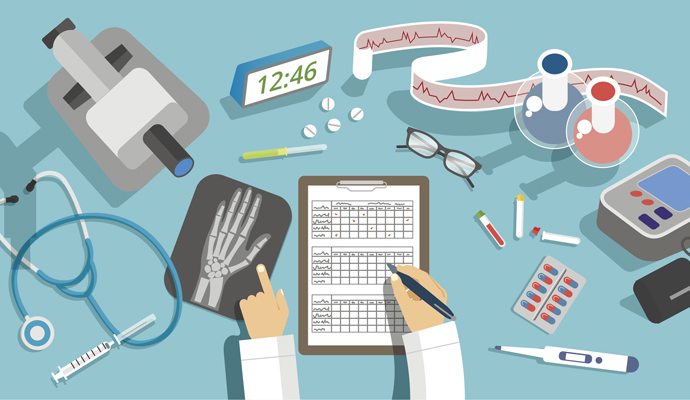In an era where technology and data play pivotal roles in shaping various industries, healthcare is no exception. Integrating data-driven strategies in patient management can potentially revolutionize healthcare delivery, enhance patient outcomes, and optimize resource utilization.
This guide highlights six key strategies for healthcare providers to effectively leverage data in patient management, fostering a more personalized and efficient approach to care.

1. Harnessing Predictive Analytics for Early Intervention
Predictive analytics has emerged as a powerful tool in healthcare, enabling providers to identify potential health issues before they escalate. By analyzing patient data, including electronic health records (EHRs), lab results, and historical health trends, healthcare providers can predict and prevent complications.
For instance, predictive analytics can help identify patients at risk of chronic conditions such as diabetes or hypertension, allowing for early intervention through personalized care plans, lifestyle modifications, and targeted interventions. This proactive approach can help improve patient outcomes while reducing the strain on healthcare resources by minimizing the need for emergency interventions.
2. Personalized Treatment Plans Through Precision Medicine
Precision medicine, a data-driven approach that tailors medical treatment to the individual characteristics of each patient, is gaining traction in patient management. By analyzing genetic, environmental, and lifestyle data, healthcare providers can create personalized treatment plans that consider the unique aspects of a patient’s biology.
This approach is particularly impactful in oncology, where genetic profiling can guide the selection of targeted therapies with higher efficacy and fewer side effects.
3. Ensuring data accuracy through data governance
As a healthcare organization, you collect a vast amount of data that you analyze to gain insight to make decisions on personalized patient treatments, predicting outcomes, etc. But very importantly, to ensure the accuracy and integrity of the data collected, you must adopt stringent data governance policies.
Data governance in healthcare provides a framework for managing the vast amount of data your clinic collects, ensuring accuracy and compliance with data laws while maintaining patient privacy. Of course, you do not want to compromise patient’s privacy in the process of obtaining their data for their treatment. Security and compliance remain essential.
4. Real-Time Remote Patient Monitoring
The rise of wearable devices and remote monitoring technology allows healthcare providers to collect real-time data on patients’ vital signs, activity levels, and overall health status. This data can be seamlessly integrated into EHRs, providing a comprehensive view of a patient’s health beyond the confines of the clinic or hospital.
Real-time remote monitoring is especially beneficial for managing chronic conditions such as heart disease, diabetes, and respiratory disorders. By continuously tracking patient data, healthcare providers can detect early warning signs of deterioration, intervene promptly, and adjust treatment plans accordingly.
5. Optimizing Resource Allocation with Data-Driven Workflow Management
Data-driven workflow management involves analyzing operational data to streamline processes, reduce inefficiencies, and enhance the overall patient experience. For example, analyzing patient flow data can help identify bottlenecks in the clinic or hospital, allowing providers to optimize appointment scheduling, staffing levels, and resource utilization.
Additionally, data-driven insights can inform decisions related to inventory management, reducing waste, and ensuring the availability of necessary medical supplies. By optimizing resource allocation, healthcare providers can enhance the quality of care, reduce wait times, and ultimately improve patient satisfaction.
5. Enhancing Patient Engagement through Data Transparency
Empowering patients with access to their own health data fosters a collaborative approach to care. Data transparency allows patients to participate in decision-making actively, understand their health status, and make informed lifestyle choices. Patient portals, mobile apps, and electronic communication tools are what healthcare providers can leverage in this regard.
Moreover, by providing patients with insights into their health trends, treatment progress, and preventive measures, healthcare providers can promote self-management and adherence to treatment plans. Increased patient engagement not only leads to better health outcomes but also contributes to more efficient use of healthcare resources by preventing unnecessary hospital visits and interventions.
6. Challenges and Considerations
While data-driven patient management holds immense potential, it comes with its fair share of challenges and considerations. Privacy and security concerns regarding patient data must be addressed through robust cybersecurity measures and data governance policies. Providers must adhere strictly to regulatory standards such as the Health Insurance Portability and Accountability Act (HIPAA).
Moreover, healthcare providers need to invest in staff training to ensure they’re versed in using these data analytics tools and interpreting results accurately.
Final Words
Without a doubt, integrating data-driven strategies in patient management represents a transformative shift in healthcare delivery. Predictive analytics, precision medicine, and remote patient monitoring are just a few pivotal strategies that can empower healthcare providers to deliver personalized, efficient, and patient-centered care.
As technology continues to advance, the continued use of data-driven patient management strategies will incredibly influence the future of healthcare.




